|
Note: Click on images to increase size.
Accessories include a variety of devices that enhance driver and passenger comfort and
safety. They include washers & wipers, horn, clock, cigarette lighter, mirrors, night vision,
navigation, satellite tracking, voice activation, passkey, keyless entry, and alarm.
(Audio devices are discussed separately.)
 Washers & wipers are always located on the windshield and may also be provided on the
rear window. Rarely they are used on the headlights. They provide the driver with a clear view while driving
in rail, snow or dust. The wiper blades are moved by a motor on the firewall of the engine compartment.
Switches with several speeds are located on the steering column or instrument panel. Windshield washer is activated
by a button. Some cars have heated windshield washer nozzles to prevent ice from clogging the inlet holes.
Some cars have rear window washers and wipers that work similarly to the windshield system. The headlight wiper &
washer system is activated automatically with the windshield system.
Washers & wipers are always located on the windshield and may also be provided on the
rear window. Rarely they are used on the headlights. They provide the driver with a clear view while driving
in rail, snow or dust. The wiper blades are moved by a motor on the firewall of the engine compartment.
Switches with several speeds are located on the steering column or instrument panel. Windshield washer is activated
by a button. Some cars have heated windshield washer nozzles to prevent ice from clogging the inlet holes.
Some cars have rear window washers and wipers that work similarly to the windshield system. The headlight wiper &
washer system is activated automatically with the windshield system.
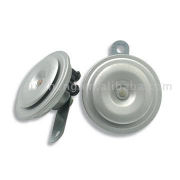 Horn are electrically operated noise-makers to give a loud warning signal to pedestrians and other
cars. One or two horns are located at the front of the car. If two horns are used, each has a different tone that
are combined to produce one sound. Pressing the horn button in the steering wheel or
column completes the circuit connecting the battery to power the horn.
Horn are electrically operated noise-makers to give a loud warning signal to pedestrians and other
cars. One or two horns are located at the front of the car. If two horns are used, each has a different tone that
are combined to produce one sound. Pressing the horn button in the steering wheel or
column completes the circuit connecting the battery to power the horn.
Mirrors located outside the front windows and inside the top of the windshield provide the
driver with rear vision while his head faces frontward.
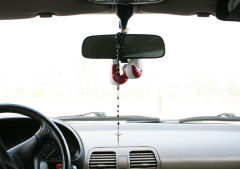
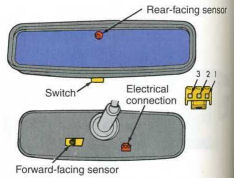
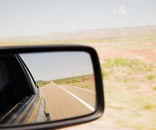
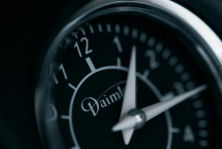 Clock provides the time of day to the occupants.
Clock provides the time of day to the occupants.
 Cigarette lighter uses an electrically heated resister coil. It can also be used as
a power outlet for mobile electrictronic devices, such as phones, laptops, CD players, PDAs, etc.
Cigarette lighter uses an electrically heated resister coil. It can also be used as
a power outlet for mobile electrictronic devices, such as phones, laptops, CD players, PDAs, etc.
 Night vision uses an infrared camera that assists the driver in fog, snow, rain, and other
atmospheric conditions that impair vision. In effect, it allows the driver to see longer distances. The
camera produces an image on the dashboard-mounted monitor or at the heads-up windshield display.
Night vision uses an infrared camera that assists the driver in fog, snow, rain, and other
atmospheric conditions that impair vision. In effect, it allows the driver to see longer distances. The
camera produces an image on the dashboard-mounted monitor or at the heads-up windshield display.
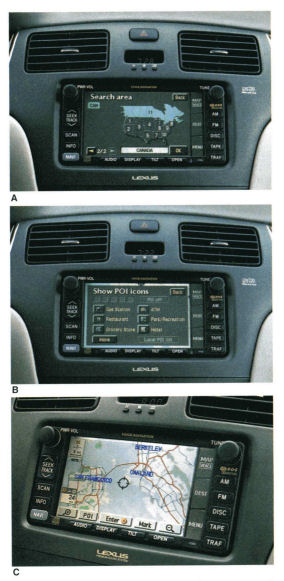 Navigation system has a cathode ray tube (CRT) that records trip information and many
control and diagnostic messages in one convenient location. Among them are turn by turn directions from the
start to end points of a trip. Some navigation systems are mobile, allowing them to
be transferred from car to car. (In the photo, A - Region of interest; B - Points of interest;
C - Routes to destination.) Console provides voice directions.
Navigation system has a cathode ray tube (CRT) that records trip information and many
control and diagnostic messages in one convenient location. Among them are turn by turn directions from the
start to end points of a trip. Some navigation systems are mobile, allowing them to
be transferred from car to car. (In the photo, A - Region of interest; B - Points of interest;
C - Routes to destination.) Console provides voice directions.
 Satellite tracking provides the driver with the car's geographical position. The Global
Positioning System (GPS) uses a geosynchronous satellite to determine positon within 300 ft (100 m). Some cars
also have a satellite connection to a driver assistance center (GM OnStar) via satellite. Subscribers can obtain
emergency service, vehicle location and other services. If the car is stolen, the system can track its location.
Satellite tracking provides the driver with the car's geographical position. The Global
Positioning System (GPS) uses a geosynchronous satellite to determine positon within 300 ft (100 m). Some cars
also have a satellite connection to a driver assistance center (GM OnStar) via satellite. Subscribers can obtain
emergency service, vehicle location and other services. If the car is stolen, the system can track its location.
 Voice activation allows for voice commands to operate some accessories. These are in
addition to manual operation. It is commonly used for cell phone operation. Voice systems recognize the driver's
voice and can respond with voice answers. It can recognize up to 2,000 commands and numeric sequences.
Voice activation allows for voice commands to operate some accessories. These are in
addition to manual operation. It is commonly used for cell phone operation. Voice systems recognize the driver's
voice and can respond with voice answers. It can recognize up to 2,000 commands and numeric sequences.
Passkey (transponder key) prevents key duplication. The key has a microchip in the head of
the key, which is a miniature transmitter. The engine management system in the engine compartment has a receiver
that can recognise the signal transmitted from the key. If the correct signals are not detected the engine will not start
and the fuel injectors will not active.
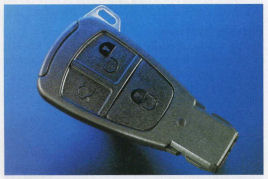 Keyless entry means using a remote device to lock and unlock doors. When the operator
presses a button the transmitter sends a signal to the receiver located in the lock control module. This closes an
electrical circuit that locks Power for the remote is provided by one or two lithium batteries.
Keyless entry means using a remote device to lock and unlock doors. When the operator
presses a button the transmitter sends a signal to the receiver located in the lock control module. This closes an
electrical circuit that locks Power for the remote is provided by one or two lithium batteries.
Alarms & Immobilizers are used as anti-theft warnings. A forced entry (breakin) via
the doors, hood, trunk, or tailgate causes the horn to sound
and the lights to flash. Also, a starter interrupt circuit prevents starting the engine and shuts off the fuel injectors.
|










![[image of flower]](../../ima/flowXS_03.gif)
![[image of flower]](../../ima/flowXS_03.gif)




